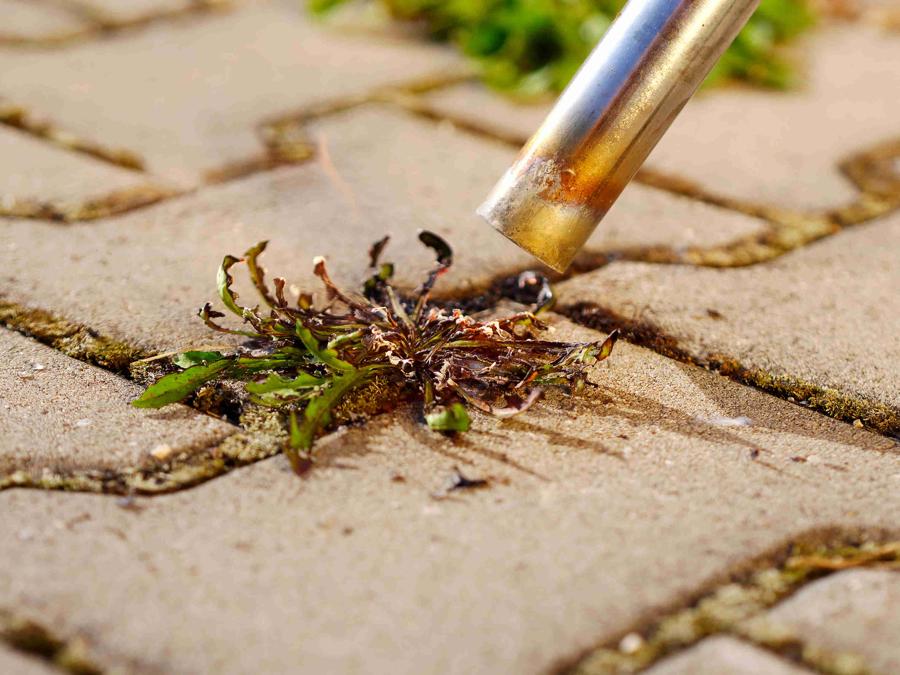Killing weeds with temperature
2023-01-02
Rune Heick
At what temperature do weeds die? already at 60-80°C does the weed start to take damage. But it is typically not just a matter of heat, but of energy. The amount of energy that can be transferred to the weed is the key factor. Typically a weed burner is around 600°C to ensure thermal chock. An alternative is water and steam also been used. The ability of This medium to contain energy does that effective weed killing can happen at temperatures as low as 90°C.
How hot should it be before weeds die? It of course depends on the weeds but for most weeds, it is lower than you might think.
Damaging the weeds cells
The goal of thermal weed treatment is not to remove the weeds directly. Rather, it is to damage the cells of the weeds stem and leaves. This will cause the weeds to die and wither away. This method kills the roots of the weeds and the treatment time is relatively short.
Weed killing temperature
At temperatures between 60-80°C most weeds do not stand a chance. That said at 60°C the exposure time is much higher than for higher temperatures. At temperatures above 60°C the proteins will take irreversible damage. Since we simply do not have hours to stand over each weed, a classic weed burner burns at 600°C. This insures thermal shock in milliseconds. Not just damaging the cells but making the cell burst, due to the water in the cells expanding.
The ambient temperature should be higher than 10°C when applying thermal treatment. Ideally above 18°C for optimal effect. Below 10°C the power has subtracted to the roots, and minimum energy is being used to sustain the stem and leaves. The weed is in hibernation mode and is waiting for spring. The good news is that it does not grow in this period. So it is not getting any worse. When burning weeds we are disrupting the photosynthetic process. Therefore burning is most efficient in sunny, warm periods.
It's all about the energy
So a weed burner is extremely hot. But there are alternatives. It is all about how much energy there can be transferred to the weed. A lot of energy in a short amount of time will do the trick of thermal damage. Air is a good insulator. This means that it is poor at transferring the heat from the burner to the weed. If we look at another material like water it is much more efficient at transferring heat. One could also heat a piece of metal and press it on the weed directly transferring energy from the metal.
Let's put some numbers on it:
| Specific Heat Capacity | Thermal conductivity | |
|---|---|---|
| Air | 1,05 kJ/(kg*K) | 0.024 (W·m^−1·K^−1) |
| Water | 4,18 kJ/(kg*K) | 0.58 (W·m^−1·K^−1) |
| Steam | 1,84 kJ/(kg*K) | 0.024 (W·m^−1·K^−1) |
| Iron | 0,444 kJ/(kg*K) | 55 (W·m^−1·K^−1) |
In the table, two factors are shown. Specific heat capacity is the amount of energy that is needed to increase the temperature 1°C for 1Kg of the substance. In other words, the medium's ability to contain energy. Thermal conductivity is how well heat can travel through the medium. To put this in the weed-killing perspective water contain much more energy than air, and when it hits the weed it transferrer the energy to the weed much quicker. Therefore the temperature can be lower.
A lot of products are out there using water and steam for thermal weed treatment for this very reason. Water with a temperature of 90-95°C is enough to archive similar effects as a weed burner.
If you an interested in steam weeding check out https://www.weedtechnics.com/blog/. They have a good post about the subject.
I have not yet seen an iron being used in the garden. I think it is unpractical. But the energy required to heat the iron would not be as high as air or water. This also means that it would need to be heated to higher temperatures to deliver the same amount of energy. It would be extremely efficient at delivering the energy so a very short expositor is needed.
Conclusion
Burning weeds is about thermal damage in the plant. This is more to do with the energy that can be transferred to the weed than the exact temperature. That said, at temperatures below 60°C you would have to wait for a long time. Using water as a heat-transferring medium allows us to lower the temperature to around 90-95°C since it contains way more energy than air. This is way less than the 600°C typically found in weed burners. A weed burner does not strictly need to be that hot but is so to combat cooling on the way from the touch to the weed.



